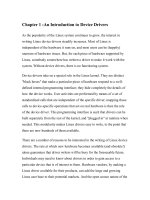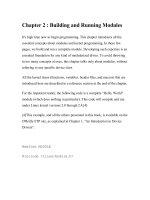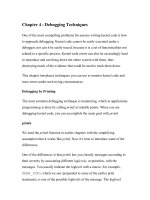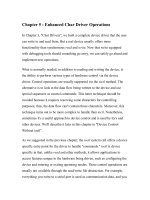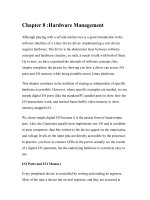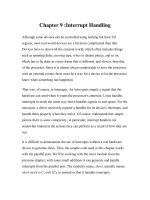linux crash course chapter 01 3
Bạn đang xem bản rút gọn của tài liệu. Xem và tải ngay bản đầy đủ của tài liệu tại đây (146.65 KB, 19 trang )
Chapter 1:
Welcome to Linux
An intro to UNIX-related
operating systems
In this chapter …
• History of Unix
• GNU-Linux
• Why Linux?
Long ago, in a galaxy far away …
• Computing power was costly
– UNIVAC cost $1 million
• CPU time was a premium
– Most mainframes had less computing power than
a calculator on the shelf at Wal-Mart
• Jobs were submitted into a queue
– Only one process at a time – scheduling
nightmare
What was needed
• Allow multiple users to access the same data
and resources simultaneously
• Service many users more cheaply than
buying each their own machine
• The ability to run multiple processes at once
• And do so while maintaining user
segregation and data integrity
Enter Unix, pride of Bell Labs
• Originally written in PDP-7 assembly
language by Ken Thompson
• To make it work on multiple architectures
(portable), Thompson rewrote Unix in B
• Dennis Ritchie developed C, and with
Thompson, rewrote Unix in C
What was so great about it?
•
•
•
•
•
Multiuser
Multiprocess
Non-proprietary
Economical for business
Initially given for free to colleges and
universities (great tactic!)
Descendents and bastards …
•
•
•
•
•
•
•
Started at Bell Labs
Picked up and continued by AT&T (SVR4)
UC Berkeley derives BSD
Sun Solaris
IRIX
Minix, XINU
Linux
What happened?
• UNIX became commercialized
• Proprietary code, specialized distributions
• Costs started to become a hindrance
• So … let’s make our own Unix …
GNU
• Richard Stallman decides that there should
be a free version of Unix available
• Forms the GNU project – GNU’s Not Unix
• Writes all of the system programs and
utilities to mimic Unix variants
• Everything but a kernel (Hurd)
Final piece
• Universities trying to teach Unix and OS
design can’t afford Unix
• Andrew Tanenbaum writes Minix
• Linus Torvalds, dissatisfied with Minix, writes
his own – Linux
GNU-Linux
• Torvalds has a perfectly functioning kernel –
but no system programs
• Finds a perfect candidate in GNU
• Together, the operating system world was
changed dramatically
Free you say?
•
•
•
•
GNU-Linux is free …
Free as in speech, not free as in beer
Free to view, copy, modify, and release
Profit still to be had from packaging, support,
and additional original code
Why Linux?
•
•
•
•
•
Software
Hardware
Portability
Standards
$$$
Software
•
•
•
•
An almost limitless library of programs
Applications, services, utilities
Many free, some commercial
Source code often available along with prebuilt binaries
Hardware
• Supports thousands of peripherals and
pieces of hardware
• Multi-platform: x86, PPC, Alpha, SPARC,
MIPS, 64-bit, SMP (multiproc systems)
• Emulation of hardware for testing and
development
Portability
• Entire operating system written in C
• Shared system libraries available for all
supported architectures
• Code written on one platform can be
compiled on any system with minimal, if any,
tweaks
Standards
• Much of GNU-Linux already meets POSIX
(Portable Operating System Interface for
Computer Environments) and Unix System V
Interface Definition (SVID)
• Standardized for commercial and
government use
And don’t forget …
• It’s free! (or at least really cheap!)
• That’s why Linux is often the operating
system of choice to teach OS design and
Unix courses
• We’ll be using RedHat Enterprise Linux 4 –
not free but a fraction of the cost of Unix
Features Overview
•
•
•
•
Multiuser
Multiprocess / Multitasking
Hierarchical Filesystem
BASH Shell command line interface /
programming language
• Many useful utilities built-in
• Rich networking support

